Economic Analysis: South Africa's Growth, Unemployment, and FDI
VerifiedAdded on 2022/10/01
|5
|1244
|417
Report
AI Summary
This report provides a macroeconomic analysis of South Africa's economic challenges, focusing on unemployment, poverty, and inequality. It examines the sluggish GDP growth, the high unemployment rates, especially among the youth, and the government's efforts to address these issues through initiatives like GEAR, AsgiSA, NGP, and NDP. The report highlights the importance of foreign direct investment (FDI) in stimulating economic growth, job creation, and the development of the service and manufacturing sectors. It discusses the shift in FDI interest from the mining sector to services and manufacturing and emphasizes the need for South Africa to attract more FDI to enhance its economic potential and become a leader in Africa. The report also references data on FDI in the services and manufacturing sectors, emphasizing the need for government initiatives to boost FDI in order to create jobs and generate wealth.
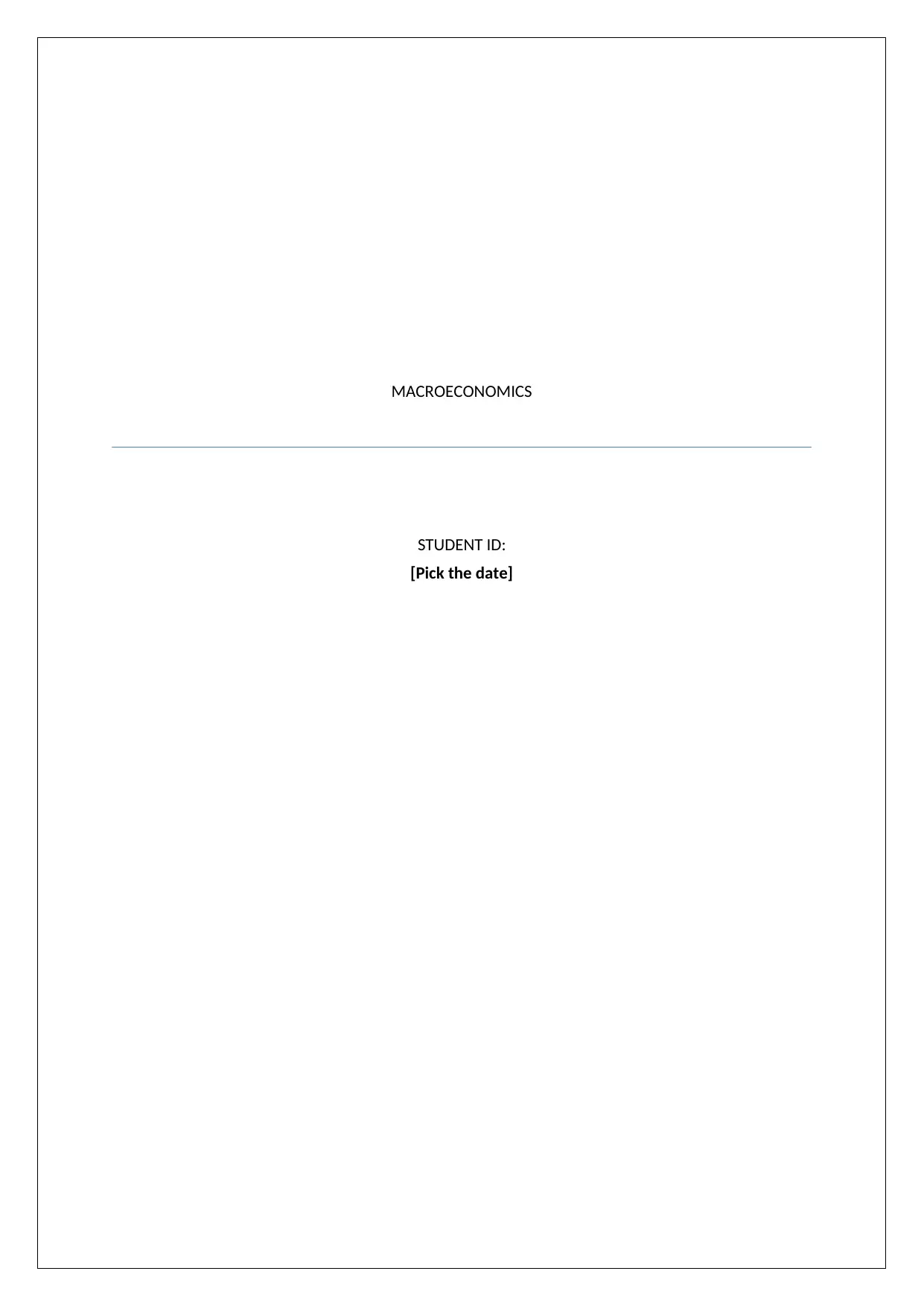
MACROECONOMICS
STUDENT ID:
[Pick the date]
STUDENT ID:
[Pick the date]
Paraphrase This Document
Need a fresh take? Get an instant paraphrase of this document with our AI Paraphraser
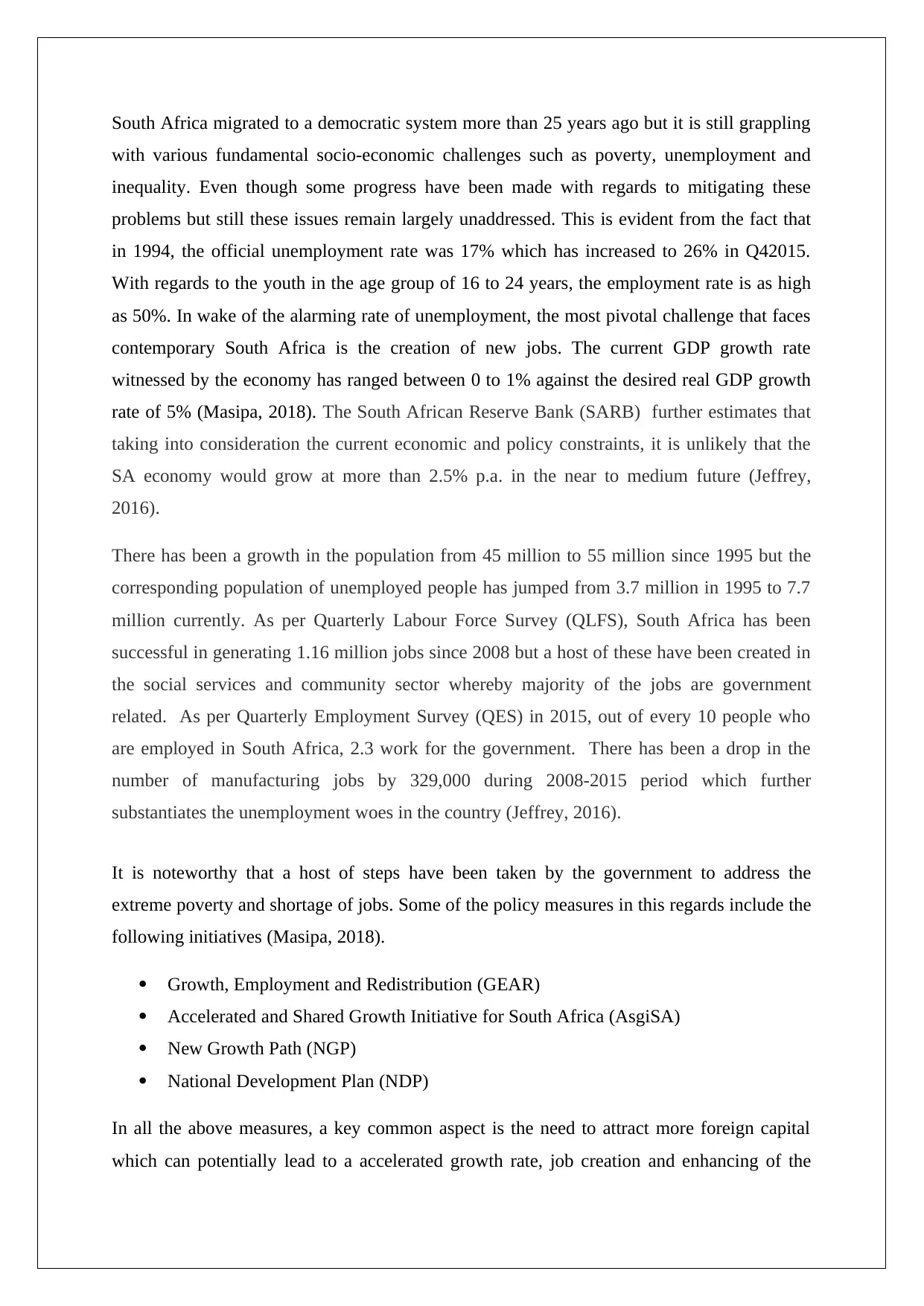
South Africa migrated to a democratic system more than 25 years ago but it is still grappling
with various fundamental socio-economic challenges such as poverty, unemployment and
inequality. Even though some progress have been made with regards to mitigating these
problems but still these issues remain largely unaddressed. This is evident from the fact that
in 1994, the official unemployment rate was 17% which has increased to 26% in Q42015.
With regards to the youth in the age group of 16 to 24 years, the employment rate is as high
as 50%. In wake of the alarming rate of unemployment, the most pivotal challenge that faces
contemporary South Africa is the creation of new jobs. The current GDP growth rate
witnessed by the economy has ranged between 0 to 1% against the desired real GDP growth
rate of 5% (Masipa, 2018). The South African Reserve Bank (SARB) further estimates that
taking into consideration the current economic and policy constraints, it is unlikely that the
SA economy would grow at more than 2.5% p.a. in the near to medium future (Jeffrey,
2016).
There has been a growth in the population from 45 million to 55 million since 1995 but the
corresponding population of unemployed people has jumped from 3.7 million in 1995 to 7.7
million currently. As per Quarterly Labour Force Survey (QLFS), South Africa has been
successful in generating 1.16 million jobs since 2008 but a host of these have been created in
the social services and community sector whereby majority of the jobs are government
related. As per Quarterly Employment Survey (QES) in 2015, out of every 10 people who
are employed in South Africa, 2.3 work for the government. There has been a drop in the
number of manufacturing jobs by 329,000 during 2008-2015 period which further
substantiates the unemployment woes in the country (Jeffrey, 2016).
It is noteworthy that a host of steps have been taken by the government to address the
extreme poverty and shortage of jobs. Some of the policy measures in this regards include the
following initiatives (Masipa, 2018).
Growth, Employment and Redistribution (GEAR)
Accelerated and Shared Growth Initiative for South Africa (AsgiSA)
New Growth Path (NGP)
National Development Plan (NDP)
In all the above measures, a key common aspect is the need to attract more foreign capital
which can potentially lead to a accelerated growth rate, job creation and enhancing of the
with various fundamental socio-economic challenges such as poverty, unemployment and
inequality. Even though some progress have been made with regards to mitigating these
problems but still these issues remain largely unaddressed. This is evident from the fact that
in 1994, the official unemployment rate was 17% which has increased to 26% in Q42015.
With regards to the youth in the age group of 16 to 24 years, the employment rate is as high
as 50%. In wake of the alarming rate of unemployment, the most pivotal challenge that faces
contemporary South Africa is the creation of new jobs. The current GDP growth rate
witnessed by the economy has ranged between 0 to 1% against the desired real GDP growth
rate of 5% (Masipa, 2018). The South African Reserve Bank (SARB) further estimates that
taking into consideration the current economic and policy constraints, it is unlikely that the
SA economy would grow at more than 2.5% p.a. in the near to medium future (Jeffrey,
2016).
There has been a growth in the population from 45 million to 55 million since 1995 but the
corresponding population of unemployed people has jumped from 3.7 million in 1995 to 7.7
million currently. As per Quarterly Labour Force Survey (QLFS), South Africa has been
successful in generating 1.16 million jobs since 2008 but a host of these have been created in
the social services and community sector whereby majority of the jobs are government
related. As per Quarterly Employment Survey (QES) in 2015, out of every 10 people who
are employed in South Africa, 2.3 work for the government. There has been a drop in the
number of manufacturing jobs by 329,000 during 2008-2015 period which further
substantiates the unemployment woes in the country (Jeffrey, 2016).
It is noteworthy that a host of steps have been taken by the government to address the
extreme poverty and shortage of jobs. Some of the policy measures in this regards include the
following initiatives (Masipa, 2018).
Growth, Employment and Redistribution (GEAR)
Accelerated and Shared Growth Initiative for South Africa (AsgiSA)
New Growth Path (NGP)
National Development Plan (NDP)
In all the above measures, a key common aspect is the need to attract more foreign capital
which can potentially lead to a accelerated growth rate, job creation and enhancing of the
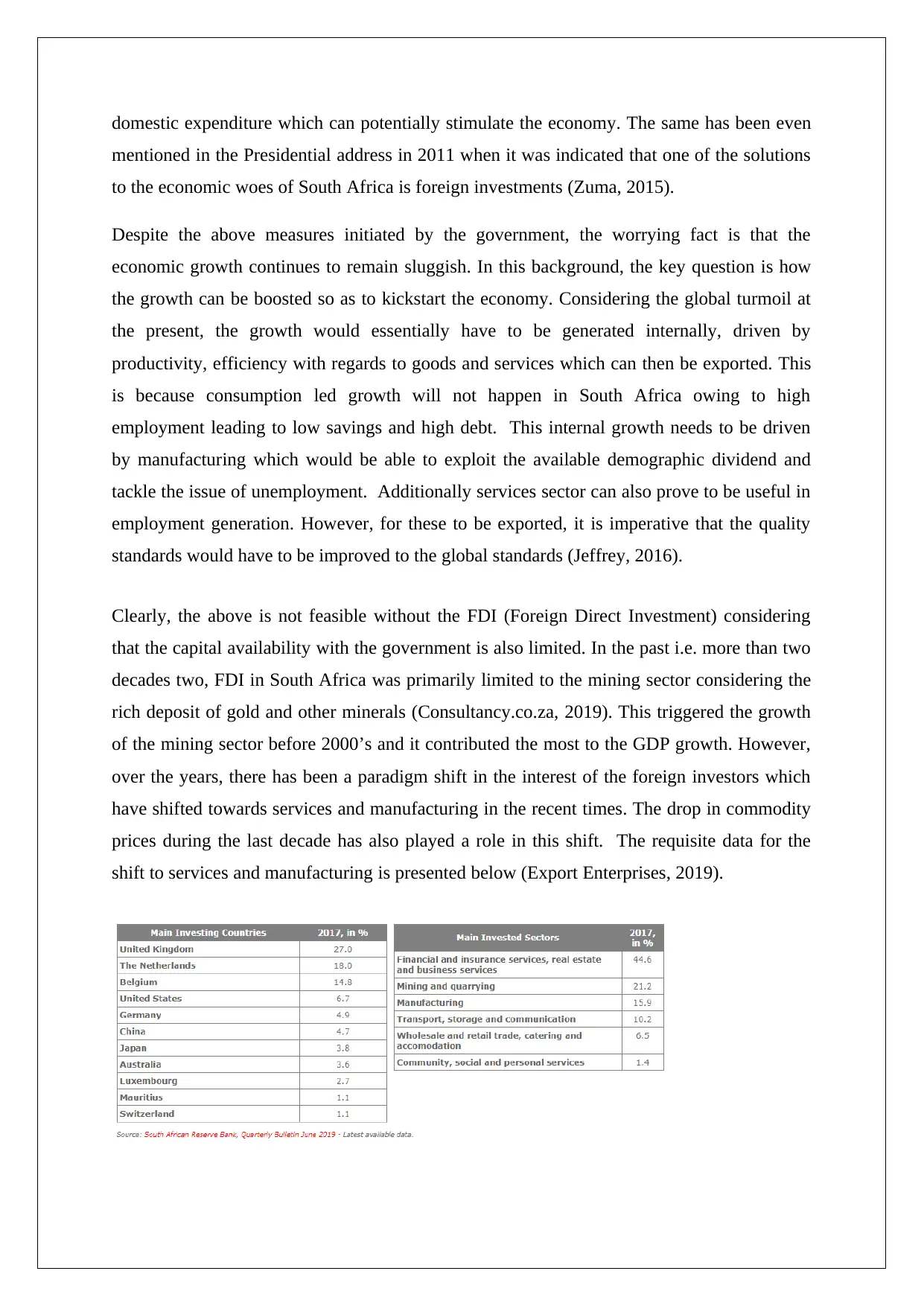
domestic expenditure which can potentially stimulate the economy. The same has been even
mentioned in the Presidential address in 2011 when it was indicated that one of the solutions
to the economic woes of South Africa is foreign investments (Zuma, 2015).
Despite the above measures initiated by the government, the worrying fact is that the
economic growth continues to remain sluggish. In this background, the key question is how
the growth can be boosted so as to kickstart the economy. Considering the global turmoil at
the present, the growth would essentially have to be generated internally, driven by
productivity, efficiency with regards to goods and services which can then be exported. This
is because consumption led growth will not happen in South Africa owing to high
employment leading to low savings and high debt. This internal growth needs to be driven
by manufacturing which would be able to exploit the available demographic dividend and
tackle the issue of unemployment. Additionally services sector can also prove to be useful in
employment generation. However, for these to be exported, it is imperative that the quality
standards would have to be improved to the global standards (Jeffrey, 2016).
Clearly, the above is not feasible without the FDI (Foreign Direct Investment) considering
that the capital availability with the government is also limited. In the past i.e. more than two
decades two, FDI in South Africa was primarily limited to the mining sector considering the
rich deposit of gold and other minerals (Consultancy.co.za, 2019). This triggered the growth
of the mining sector before 2000’s and it contributed the most to the GDP growth. However,
over the years, there has been a paradigm shift in the interest of the foreign investors which
have shifted towards services and manufacturing in the recent times. The drop in commodity
prices during the last decade has also played a role in this shift. The requisite data for the
shift to services and manufacturing is presented below (Export Enterprises, 2019).
mentioned in the Presidential address in 2011 when it was indicated that one of the solutions
to the economic woes of South Africa is foreign investments (Zuma, 2015).
Despite the above measures initiated by the government, the worrying fact is that the
economic growth continues to remain sluggish. In this background, the key question is how
the growth can be boosted so as to kickstart the economy. Considering the global turmoil at
the present, the growth would essentially have to be generated internally, driven by
productivity, efficiency with regards to goods and services which can then be exported. This
is because consumption led growth will not happen in South Africa owing to high
employment leading to low savings and high debt. This internal growth needs to be driven
by manufacturing which would be able to exploit the available demographic dividend and
tackle the issue of unemployment. Additionally services sector can also prove to be useful in
employment generation. However, for these to be exported, it is imperative that the quality
standards would have to be improved to the global standards (Jeffrey, 2016).
Clearly, the above is not feasible without the FDI (Foreign Direct Investment) considering
that the capital availability with the government is also limited. In the past i.e. more than two
decades two, FDI in South Africa was primarily limited to the mining sector considering the
rich deposit of gold and other minerals (Consultancy.co.za, 2019). This triggered the growth
of the mining sector before 2000’s and it contributed the most to the GDP growth. However,
over the years, there has been a paradigm shift in the interest of the foreign investors which
have shifted towards services and manufacturing in the recent times. The drop in commodity
prices during the last decade has also played a role in this shift. The requisite data for the
shift to services and manufacturing is presented below (Export Enterprises, 2019).
⊘ This is a preview!⊘
Do you want full access?
Subscribe today to unlock all pages.

Trusted by 1+ million students worldwide
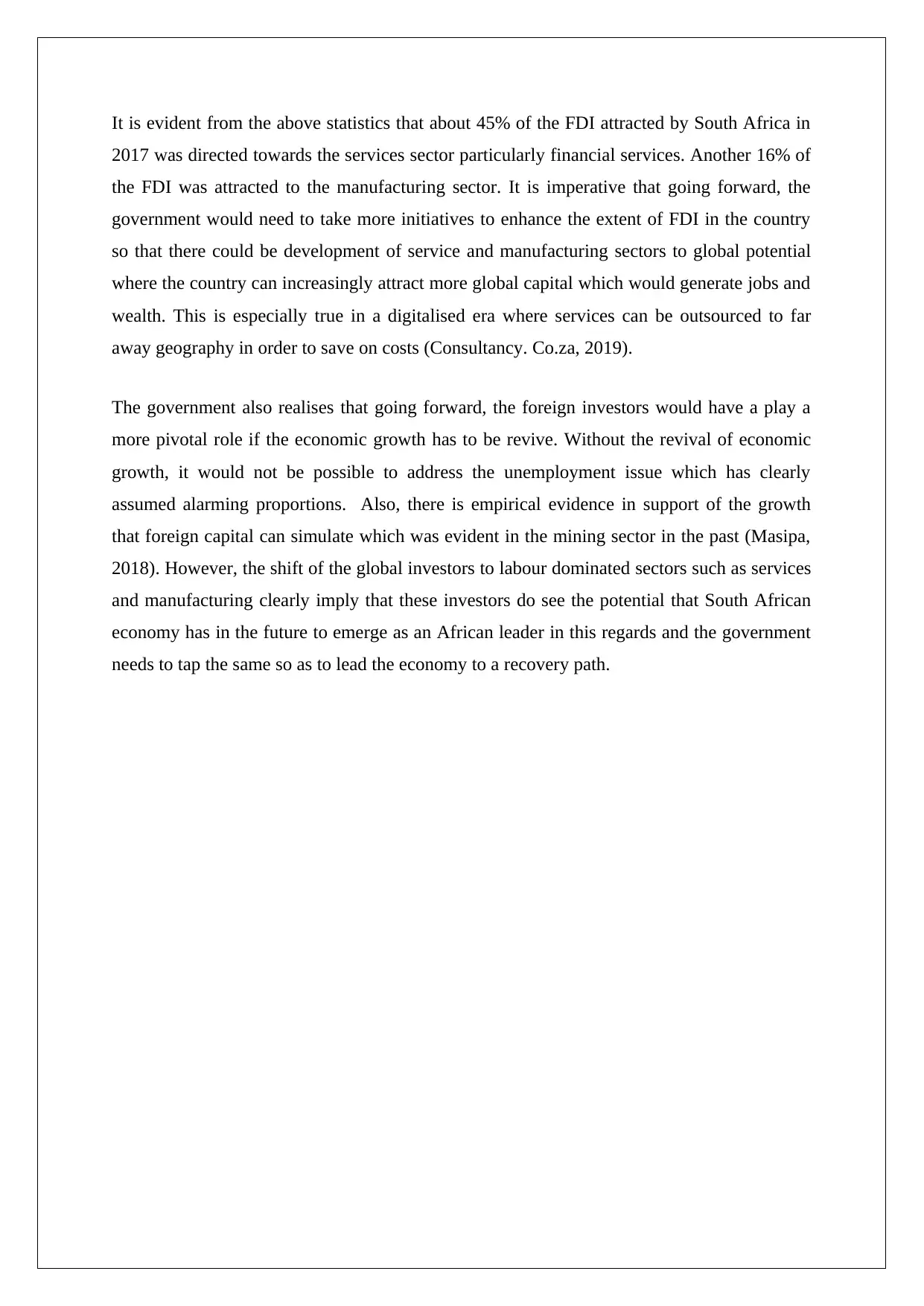
It is evident from the above statistics that about 45% of the FDI attracted by South Africa in
2017 was directed towards the services sector particularly financial services. Another 16% of
the FDI was attracted to the manufacturing sector. It is imperative that going forward, the
government would need to take more initiatives to enhance the extent of FDI in the country
so that there could be development of service and manufacturing sectors to global potential
where the country can increasingly attract more global capital which would generate jobs and
wealth. This is especially true in a digitalised era where services can be outsourced to far
away geography in order to save on costs (Consultancy. Co.za, 2019).
The government also realises that going forward, the foreign investors would have a play a
more pivotal role if the economic growth has to be revive. Without the revival of economic
growth, it would not be possible to address the unemployment issue which has clearly
assumed alarming proportions. Also, there is empirical evidence in support of the growth
that foreign capital can simulate which was evident in the mining sector in the past (Masipa,
2018). However, the shift of the global investors to labour dominated sectors such as services
and manufacturing clearly imply that these investors do see the potential that South African
economy has in the future to emerge as an African leader in this regards and the government
needs to tap the same so as to lead the economy to a recovery path.
2017 was directed towards the services sector particularly financial services. Another 16% of
the FDI was attracted to the manufacturing sector. It is imperative that going forward, the
government would need to take more initiatives to enhance the extent of FDI in the country
so that there could be development of service and manufacturing sectors to global potential
where the country can increasingly attract more global capital which would generate jobs and
wealth. This is especially true in a digitalised era where services can be outsourced to far
away geography in order to save on costs (Consultancy. Co.za, 2019).
The government also realises that going forward, the foreign investors would have a play a
more pivotal role if the economic growth has to be revive. Without the revival of economic
growth, it would not be possible to address the unemployment issue which has clearly
assumed alarming proportions. Also, there is empirical evidence in support of the growth
that foreign capital can simulate which was evident in the mining sector in the past (Masipa,
2018). However, the shift of the global investors to labour dominated sectors such as services
and manufacturing clearly imply that these investors do see the potential that South African
economy has in the future to emerge as an African leader in this regards and the government
needs to tap the same so as to lead the economy to a recovery path.
Paraphrase This Document
Need a fresh take? Get an instant paraphrase of this document with our AI Paraphraser
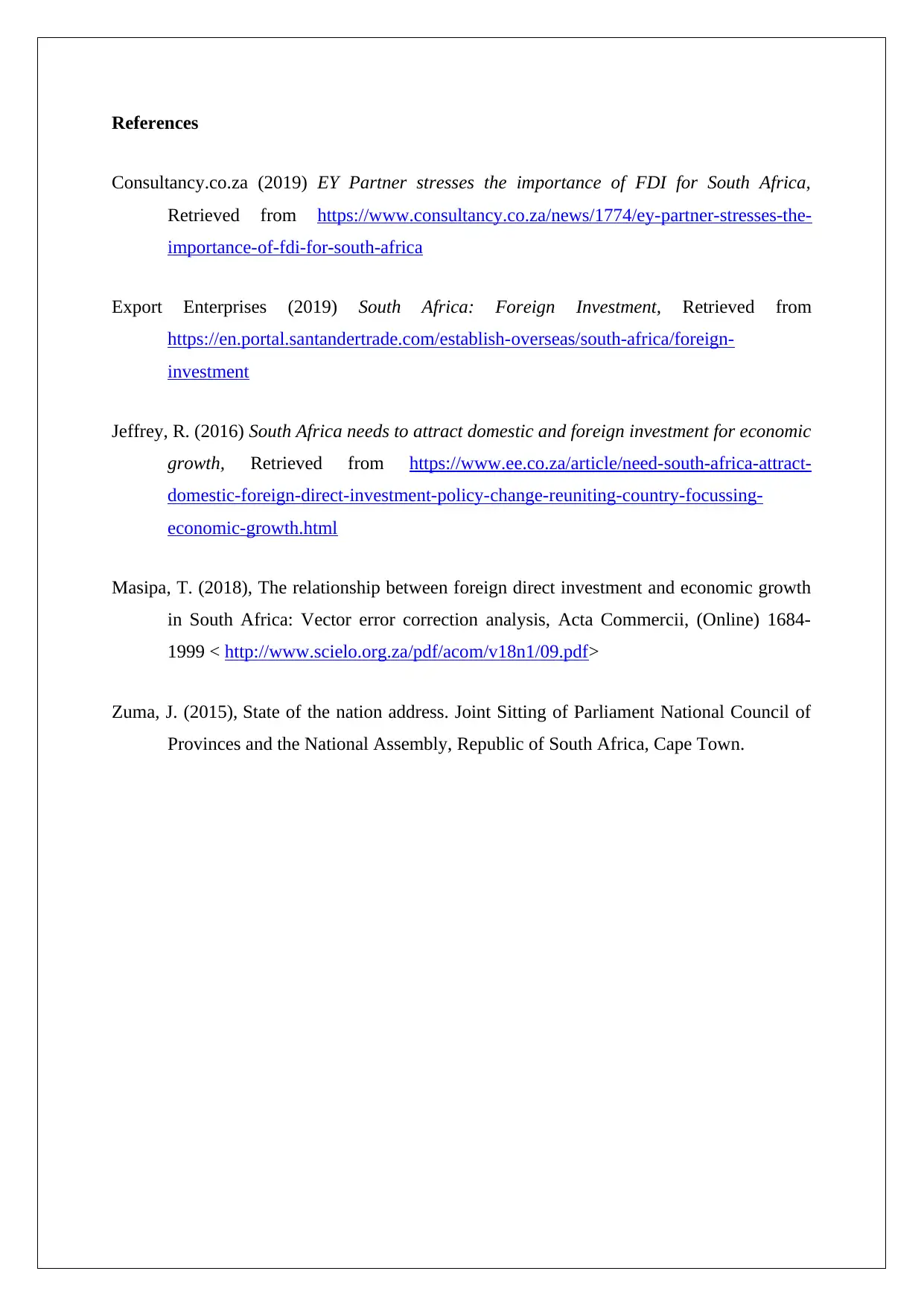
References
Consultancy.co.za (2019) EY Partner stresses the importance of FDI for South Africa,
Retrieved from https://www.consultancy.co.za/news/1774/ey-partner-stresses-the-
importance-of-fdi-for-south-africa
Export Enterprises (2019) South Africa: Foreign Investment, Retrieved from
https://en.portal.santandertrade.com/establish-overseas/south-africa/foreign-
investment
Jeffrey, R. (2016) South Africa needs to attract domestic and foreign investment for economic
growth, Retrieved from https://www.ee.co.za/article/need-south-africa-attract-
domestic-foreign-direct-investment-policy-change-reuniting-country-focussing-
economic-growth.html
Masipa, T. (2018), The relationship between foreign direct investment and economic growth
in South Africa: Vector error correction analysis, Acta Commercii, (Online) 1684-
1999 < http://www.scielo.org.za/pdf/acom/v18n1/09.pdf>
Zuma, J. (2015), State of the nation address. Joint Sitting of Parliament National Council of
Provinces and the National Assembly, Republic of South Africa, Cape Town.
Consultancy.co.za (2019) EY Partner stresses the importance of FDI for South Africa,
Retrieved from https://www.consultancy.co.za/news/1774/ey-partner-stresses-the-
importance-of-fdi-for-south-africa
Export Enterprises (2019) South Africa: Foreign Investment, Retrieved from
https://en.portal.santandertrade.com/establish-overseas/south-africa/foreign-
investment
Jeffrey, R. (2016) South Africa needs to attract domestic and foreign investment for economic
growth, Retrieved from https://www.ee.co.za/article/need-south-africa-attract-
domestic-foreign-direct-investment-policy-change-reuniting-country-focussing-
economic-growth.html
Masipa, T. (2018), The relationship between foreign direct investment and economic growth
in South Africa: Vector error correction analysis, Acta Commercii, (Online) 1684-
1999 < http://www.scielo.org.za/pdf/acom/v18n1/09.pdf>
Zuma, J. (2015), State of the nation address. Joint Sitting of Parliament National Council of
Provinces and the National Assembly, Republic of South Africa, Cape Town.
1 out of 5
Related Documents
Your All-in-One AI-Powered Toolkit for Academic Success.
+13062052269
info@desklib.com
Available 24*7 on WhatsApp / Email
![[object Object]](/_next/static/media/star-bottom.7253800d.svg)
Unlock your academic potential
Copyright © 2020–2025 A2Z Services. All Rights Reserved. Developed and managed by ZUCOL.





